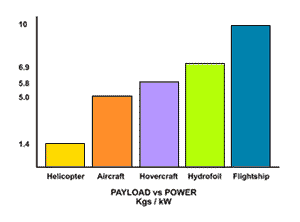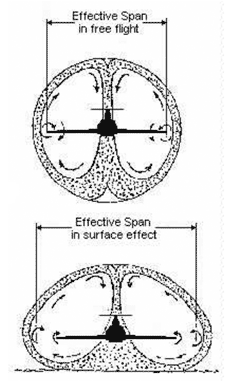
Wing in Ground Effect Aerodynamics
Around 1920 this effect was first described and some (theoretical) research was carried out in this field. From that time on pilots knew ground effect and sometimes even used it on purpose. The flying boat Dornier DO-X could only cross the Atlantic when it was flying with its hull just above the wave crests. In the Second World War pilots knew that when they lost an engine on the way back from the enemy that they could reach home by flying just a few meters above the sea, thus needing less power. The very well known Spruce Goose, the largest aircraft ever, never even left ground effect in its only 90 second flight! When an aerodynamic wing is close to a ground plane, such as water, lift is increased by as much as 45% and induced drag decreased by up to 70%. This is vastly different to normal operation of an aircraft wing in free flight away from the ground. The main benefits when a craft is operating within ground effect are that speed, payload and fuel economies are considerably more efficient than with traditional boat, plane and helicopter transport.
A hovercraft rides on a cushion of air created by a fan that blows into a cavity under the hull; this forms a 'static cushion'. The cushion reduces the frictional drag of the hovercraft with the surface beneath it; this is then known as ground effect.
Ground Effect is the name given to the dramatically improved aerodynamic performance of a wing when it operates close to a ground plane.
Wing in Ground Effect (WIG) is the official term adopted by the United Nations International Maritime Organization (IMO) and the United Nations International Civil Aviation Organization (ICAO) for a marine craft using ground effect as a means of lift. Ever since the beginning of manned flight pilots have experienced something strange when landing an aircraft. Just before touchdown it suddenly feels like the aircraft just doesn't want to go lower. It just wants to go on and on due to the air that is trapped between the wing and the runway, forming an air cushion. The air cushion is best felt in low wing aircraft with large wing areas. This phenomenon is called (aerodynamic) ground effect. The Wright brothers probably had not even flown out of ground effect in their early flights, they benefited from ground effect without even knowing it existed.

Because of using power for lift as well as propulsion, a hovercraft uses excessive fuel and makes a great deal of noise, somewhat like a helicopter when close to the ground. The downward hovering thrust causes large amounts of debris to be thrown up into the air with negative impacts on the eco-system when operating over land, or in shallow waters.
By comparison, a WIG craft also rides on a cushion of air, but instead of a lift engine and fan the cushion is created and maintained by forward motion. This is called a 'dynamic cushion'. A WIG craft, when compared to a hovercraft of equivalent size, creates less noise, is far more fuel efficient, and does not produce this typical damage to the environment.

What is Ground Effect?
Two phenomena are involved when a wing approaches the ground. Ground effect is one name for both effects which is sometimes confusing. The two phenomena are sometimes referred to as span dominated and chord dominated ground effect. The former results in a reduction of induced drag (D) and the latter in an increase of lift (L). The overall effect is an increase of the L/D ratio. This ratio is a measure for the efficiency of an aircraft which can be expressed as the amount of power (thrust) that is required to propel an aircraft of a certain weight. Since thrust is equal to drag and weight is equal to lift in stationary flight this efficiency can be expressed as the L/D ratio. As the L/D of a wing increases with decreasing ground clearance the craft becomes more efficient in ground effect.
Span Dominated Ground Effect

When aeronautical engineers mention ground effect they usually mean span dominated ground effect. The drag of an aircraft can be split up into different contributions. The two main sources of drag are called friction drag and induced drag. As the name suggests the friction drag is caused by friction of the air on the skin of the craft and is therefore dependent on its wetted area.
Induced drag is sometimes also called lift induced drag because it is the drag due to the generation of lift. When a wing generates positive lift the static pressure on the lower side of the wing is higher than on the upper side. The (average) pressure difference times the surface area of the wing is equal to the lift force. At the wingtip there is a complication: the high pressure area on the lower side meets the low pressure area on the upper side therefore the air will flow from the lower side to the upper side, around the wingtip. This is called the wingtip vortex. These vortices are found with all aircraft in flight; sometimes they are visible at an air show: when a fighter flies at a high angle of attack, the water in the air condenses in the low pressure vortex and you see two curled lines extending backwards from the wingtips. The energy that is stored in those vortices is lost and is experienced as drag.
The amount of induced drag is dependent on the spanwise lift distribution and the aspect ratio of the wing. It was found (theoretically) that the spanwise lift distribution should be elliptic. A high aspect ratio wing has lower induced drag than a low aspect ratio wing since its wingtip vortices are weaker. That is because the rest of the wing is "further away" from the tip so that the high and low pressure areas at the tip are smaller.
There is not enough space for the vortices to fully develop when a wing is approaching the ground. Therefore the amount of "leakage" of pressure from the lower side is less and the vortices become weaker. The vortices are also pushed outward by the ground; apparently the effective aspect ratio of the wing becomes higher than the geometric aspect ratio. This is a common way to account for spanwise ground effect. Wieselsberger has (theoretically) found this in the 1920's by applying Prandtls lifting line theory. From this theory it follows that induced drag reduces to approximately 50% at a ground clearance of 10% of the wingspan.
Chord Dominated Ground Effect
The high pressure air cushion can clearly be seen in the pictures above. The red color indicates a high pressure; green is ambient pressure and blue is low pressure. Apart from ram effect there is more to be seen in the pictures: the blue area around the nose of the profile indicates the suction peak on the leading edge of the wing. The suction is far more distinct in ground effect; this indicates that separation is likely to occur at the nose. This has been confirmed by wind tunnel tests.
As described above, ground effect increases lift. The air cushion is created by high pressure that builds up under the wing when the ground is approached. This is sometimes referred to as ram effect, or ram pressure. When the ground distance becomes very small the air can even stagnate under the wing, this gives the highest possible pressure, pressure coefficient unity.


L/D ratio

Longitudinal Stability
The combined result of the two phenomena described above is an overall increase of the ratio between the lift and the drag (L/D).
The L/D ratio is commonly used to express the efficiency of a vehicle. When a vehicle is in stationary motion its weight is equal to its lift and its propulsive thrust is equal to its drag, therefore the L/D ratio is an expression for the amount of weight that can be carried with a certain amount of thrust.
The higher this ratio, the higher its efficiency and the lower its fuel consumption (for a given weight).
The maximum L/D of an airliner in cruise flight is close to 20 and smaller aircraft may be around 15. Already in the early sixties Lippisch showed that in ground effect higher values could be reached, his X-112 got as high as 23 in ground effect flight.
Ever since the very first experimental WIG vehicles have been built in the thirties longitudinal stability has been recognized as a very critical design factor. When not designed properly WIG craft show a potentially dangerous pitch up tendency when leaving (strong) ground effect. Powerboats sometimes show the same tendency, when they meet a wave or a wind gust they may suddenly flip backwards.
The reason for this behavior is the fact that the working line of the lift vector of a wing goes through the centre of the wing at (theoretical) zero ground distance, whereas it goes through the quarter chord point in free air. The problem can be overcome by installing a relatively large horizontal tail and choosing the correct centre of gravity (at 40 to 45% of the mean aerodynamic chord).
Some wing platforms are more stable than others, the reversed delta from Lippisch proved to be very good, therefore it has been very popular lately. Not only the platform, but also the wing section is important for stability. Recent research showed that wing sections with an S-shaped camber line are more stable than conventional wing sections.
This information was excerpted with permission from The WIG Page where you can find additional information on WIG technology and history.

